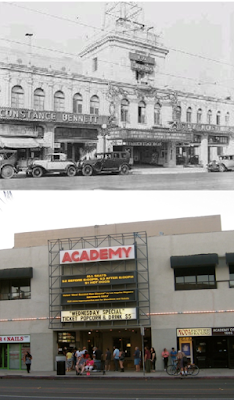VIVE LE DISCOUNT MOVIE HOUSE!
$3.00 admission all day, every day! $1.50 on Sundays and
Tuesdays! Free parking! $1 hot dogs that are actually safe to eat, and tasty!
Digital projection! Good popcorn! Family-friendly environs! Do you have a discount
theater in your neighborhood? If so, count yourself very lucky indeed. Where I
live, in Glendale, CA, USA, I’m within cycling distance of at least three
overpriced, technically underwhelming “luxury” cinemas which charge
outrageously high admission fees for the “privilege” of posh seating (there’s
usually a heavily padded recliner involved) and even in-your-seat service
which, so far as I’ve seen, equals and sometimes even beats the shining beacon
of a cell phone light or a loud conversation between movie pals as a
distraction from the picture on the screen. But I only have to pedal a little
ways further (truth be told, I usually drive) to avail myself of the second-run
pleasures of two little ramshackle discount multiplexes that offer all the bargains
listed above, and probably a couple others I have yet to sniff out.
The Academy Theater in Pasadena, owned and operated by the
Regency Cinemas chain, is a hastily renovated movie palace that still looks a
bit rundown on entry to its once-ornate lobby. (It was originally the Fox
Theater, designed by the same gentleman who created the plans for Pasadena’s
other movie palace, the Rialto, and became in the Academy in the late ‘50s.)
Inside, the auditoriums are laid out as though the architect’s main tool was a
chainsaw, but the Academy is still a great place to catch up on any big,
popular, or would-be popular mainstream Hollywood fare mired in the purgatory
between first-run theatrical engagements and the promised land of Blu-ray,
streaming and digital downloads.
And though the Academy is geographically closer to where I
live, I tend to gravitate toward the Valley Plaza 6 in North Hollywood,
Regency’s real success story in bargain movie multiplex culture. The Valley
Plaza 6 is no great shakes in the architecture department either. Once owned by
the United Artists chain, it’s a pretty typical ‘70s-‘80s cracker-box
complex—two auditoriums built to hold around 500 customers, the other four
around 150, with little to no amenities of style or presentation, all function,
no form. With the advent of new and even bigger multiplexes featuring
stadium-style auditoriums and reserved seating, this old school Cineplex looked
to be on the way out. But several years ago Regency refashioned it as a
discount house and now the place flourishes as a reasonable alternative to $15
first-run ticket prices.
In many ways, the success of the Valley Plaza 6 and other
theaters like it mirror the mini resurgence that drive-in theaters, in Southern
California and elsewhere around the country, have enjoyed over the past 10
years. Once thought of as a fleapits attracting exactly the sorts of audiences
(young, rude, possibly criminally oriented) that would keep the general
populace tucked safely away in front of their 60-inch screens at home, drive-in
movie theaters are now, against all odds, primarily family-friendly locations,
emphasizing affordable entertainment options for parents and children who want
a fun moviegoing experience without having to take out a loan to pay for it.
Similarly, you used to be able to count on a show outside
the Valley Plaza 6, located on the border of North Hollywood and Panorama City
in the San Fernando Valley, where street racers and other young toughs would
loiter after dark in the theater’s vast parking lot, spinning 360s in their
tricked-out rides and unnerving moviegoers headed back their own
far-more-modest vehicles. But these days, the Valley Plaza 6 has been co-opted
by audiences who wouldn’t look out of place at the drive-in—parents and excited
children, alongside young couples looking for an affordable night out, everyone
having a good time undoubtedly fueled by the buzz that only buying a $3 ticket
to see an (almost) new movie can provide. (Those prices are cheaper than
drive-in admissions even!)
And I used to think of second-run houses as places where the
discounted admission was code for a trade-off that almost always included
seeing a beat-up print that had been abused by indifferent or incompetent
projectionists on its journey to the end of the theatrical road. But no more.
The presentation at the Valley Plaza 6 has benefited greatly from the presence
of 35mm’s mortal enemy, digital projection. When the Valley Plaza 6 was running
film, the projection was always highly variable in quality and one could never
count on whether or not the movie would even be shown in the correct aspect
ratio. (Scope prints were routinely masked down to 1.85:1 in the smaller
auditoriums.) But now, also like drive-ins, the Valley Plaza 6 offers
projection that is comparable, and sometimes even better, than some of the
higher-priced options around town—a few weeks ago I saw Spy at a renovated first-run multiplex with fancy recliner chairs
and reserved seating and was horrified to discover the digital presentation of
the feature looked no different than the flimsy, washed-out video quality of
the pre-show “content.” For $13 a ticket!
Programming at the Valley Plaza 6 is hit and miss, as it is
in first-run houses, but especially so if you tend to keep up with new releases
and arthouse fare at other venues. However, it’s always a good idea of keep an
eye on the schedule (I get e-mail alerts every week), because sometimes the
stars they do align and room is made for something other than crappy comedies
(I’m looking at you, Paul Blart: Mall Cop
2) or CGI animation. This past weekend my daughter and I found ourselves at
the Valley Plaza 6 for a do-it-yourself double bill of the recent Poltergeist remake and Brad Bird’s Tomorrowland, neither of which exactly
set the box office on fire and both of which made their way out of first-run
theaters with relative haste, and we had a great time.
A quick look at the schedule for the upcoming weekend at
the Valley Plaza 6 reveals that both Poltergeist
and Tomorrowland (and Paul Blart: Mall Cop 2) will continue
their runs, along with the addition of Ted
2, Pitch Perfect 2 and the Reese Witherspoon-Sofia Vergara chase comedy Hot Pursuit. Meanwhile over at the Academy Theater in Pasadena, if you’re among those who wish they could have
caught (or were afraid to catch) Insidious
Chapter 3, Entourage or Cameron Crowe’s much-maligned Aloha upon their initial releases, well, here’s your chance, and at
prices that won’t make you feel utterly cheated, should the movies themselves
turn out to be as bad as their reputations. If you live in another part of the
country and have a discount house near you, there’s probably a similar roster
of programming available this weekend as well, so take heart. As admission
prices continue to rise, it’s nice to know there are options for economically
minded audiences who choose to read the fine print of the newspaper listings (Newspaper?
What’s that?) or click on the theater’s Web site and take advantage.
Vive le $3 ticket! Vive le $1 hot dog! Vive le discount movie house, wherever it may be, whatever form it may take!
Vive le $3 ticket! Vive le $1 hot dog! Vive le discount movie house, wherever it may be, whatever form it may take!
****************************************
(Critical aside: The Poltergeist remake is certainly unnecessary, but even so it stands up well against the 1982 original, which I’ve never held in very high regard. The new version is clearly much more grounded in PG-13-scaled horror, as opposed to the Hooper/Spielberg film, which as I rediscovered in watching it again last night, is more a Spielbergian light show than a haunted house movie, the entire cast directed to stare into the strobes displaying the director’s patented Gaping Maw of Awe as if the movie were a supernatural wrinkle on Close Encounters of the Third Kind, which maybe it is. The remake trades in the original’s very charming loosey-goosey family dynamic for one imbued with a more stressful 2015-ready economic uncertainty, but it doesn’t really pay off. Where the new version shines is in its casting. As good as Craig T. Nelson is, Sam Rockwell’s is the more interesting paternal performance, and the paranormal tag team of Jane Adams and Jared Harris represent a significant upgrade over Beatrice Straight and Zelda Rubenstein. However, as good as she is, Rosemarie DeWitt can’t touch JoBeth Williams, without whom the 1982 would have no reason to exist. Both movies are ultimately underwhelming, but the new Poltergeist is much better than Rotten Tomatoes would have you believe, and my daughter and I enjoyed its many effective scares.
That goes double for Tomorrowland, a movie marketed as a kids’ adventure tale (and none too ably marketed, I guess) which, in the tradition of the most serious and socially engaged science fiction literature and films, has some deadly serious things to say about our pop culture’s romance/infatuation/obsession with all things dystopian. Critic David Edelstein rightly called it “a major pop-culture statement with all sorts of implications, both vital and nutty,” locating the “nutty” part somewhere near director Bird’s assertion of “imagination over knowledge.” Bird suggests that recognition of problems like global warming, which might well lead to the sort of post-apocalyptic fate movies and television shows and young-adult literature are so in love with, shouldn’t be allowed to overwhelm our need to band together and create solutions to preserve our future. I couldn’t quite make the leap toward accepting that Bird’s movie believes that those most vocal about impending disaster are dampening the creative spirits of those most likely to find a way to right our listing global ship. But even if that’s the feeling you take from it, at least it’s a position that can be argued and examined in the aftermath of the exhilarating storytelling buzz the movie leaves you with. Bird's ability to conjure access to both the grandeur of classic sci-fi and the swift grace and sharp wit of his animated features is at a peak in Tomorrowland. Critical aside concluded.)
*************************************
*************************************


























1 comment:
My feeling about Tomorrowland is that I didn't want go to the World of Tomorrow, I wanted to go to the antique toy shop. The problem isn't that people have stopped believing in the future portrayed in the two New York World's Fairs, it's that they live in it. The smart phone in your pocket does more than the ones they had on Star Trek. What you find though when you get there is that the future is still just life on Earth, with all its petty oppressions, regardless of how fancy your gadgets are. Like Interstellar, Tomorrowland is primarily shilling for manned space travel, i.e., spending billions of dollars to send a privileged few to a wasteland. As the close-up pictures of Pluto we've just gotten attest, space exploration achieves the most when you leave the people behind.
My favorite second-run discount house in L.A. was the Oriental, an old-time neighborhood theater on Sunset that was a movie's last stop on the way out of town. But you know, the first of the "premium" theaters in L.A., opened as The Bridge but now Rave 18 has a $6.00 all day bargain day on Tuesdays with first run pictures. It's across the street from where I work so I'm in and out of there all the time.
Post a Comment